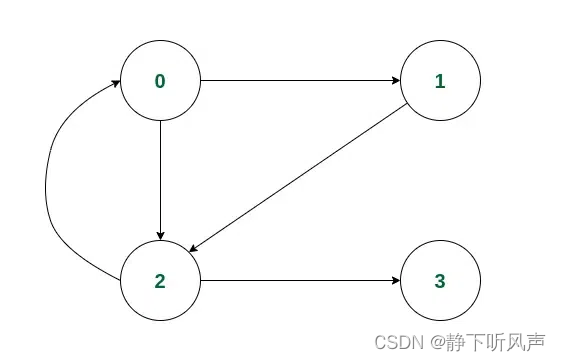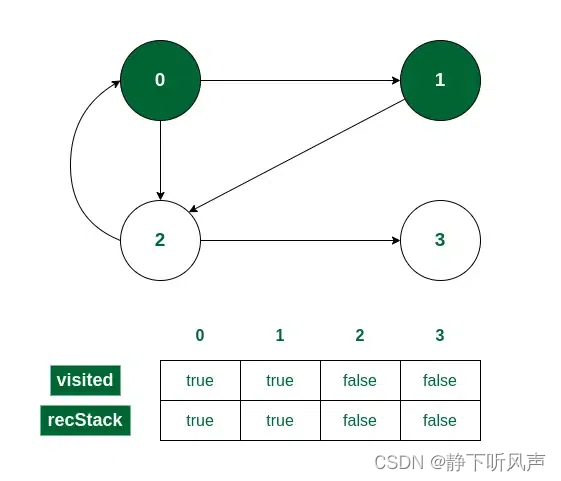给出一个有向图的根节点,判断这个图中是否包含环
例如:
输入:N = 4, E = 6

输出:Yes
说明:由上图可清楚看出环形路径:0 -> 2 -> 0
再如:
输入:N = 4, E = 4

输出:No
说明:上图中不存在环
1.DFS检查有向无环图中环的存在
这个方法思路基于如下:
利用深度优先遍历判断有向图中存在环。基本思想是只有当图中存在指向前置节点的边(暂且称为回向边)时才可能存在环。
为了检测回向边的存在,我们需要标记已经访问过的节点和递归栈(即目前我们的访问路径)中已保存的结点。在递归过程中如果到达的节点已经在递归栈中,说明当前图中存在环。
注意:如果有向图是不连通的,需要获取整个图的森林并分别在各个子图中检查回向边的存在
上述思路的实现步骤:
- 创建一个递归的dfs函数,包含如下参数:当前节点,已遍历节点的数组和递归栈
- 标记当前节点为visited并且将其加入到递归栈中
- 遍历所有节点,对于每个未遍历过的节点调用递归函数(这一步是考虑当前图是一个森林,我们检查每一个子图):
- 在每个递归调用,找出当前节点的所有未访问过的相邻节点:
- 如果一个相邻节点已经存在于递归栈中则说明有环,返回true
- 否则对每个相邻节点调用递归函数
- 当递归调用返回时,清除递归栈中的当前节点,用以代表当前节点不再是已访问路径的一部分
- 在每个递归调用,找出当前节点的所有未访问过的相邻节点:
- 只要任何一个递归调用返回true,停止之后的所有函数调用,并返回true作为结果
示例:
存在如下图:

当我们从节点0开始遍历查找:
- 首先,0会被加入到visited[]和recStack[]数组中作为当前路径的一个节点
- 现在0的两个相邻节点是1 和 2,假设遍历到节点1 ,那么节点1将会加入到visited[]和recStack[]

- 节点1的相邻节点只有一个,递归调用节点2,并将其加入visited[]和recStack[]

Vertex 2 is visited - 节点2有两个相邻节点
- 节点0已经访问过并且已经存在于recStack[],因此如果先检查的是节点0,我们将得到结果是图中存在环
- 另一方面,若先检查的是节点3,那么节点3将会在visited[]和recStack[]数组中

Vertex 3 is visited
- 当节点3的递归调用返回时,它将从recStack[]中清除,因为节点3现在不是当前路径的一部分

Vertex 3 is unmarked from recStack[] - 现在只剩下一个相邻节点0,它已经存在于recStack[]
因些可以得出结论图中存在环。同样地,如果从0节点的相邻节点2开始查找也会得出相同结论。
以下是代码实现:
// A Java Program to detect cycle in a graph
import java.util.ArrayList;
import java.util.LinkedList;
import java.util.List;
class Graph {
private final int V;
private final List<List<Integer> > adj;
public Graph(int V)
{
this.V = V;
adj = new ArrayList<>(V);
for (int i = 0; i < V; i++)
adj.add(new LinkedList<>());
}
// Function to check if cycle exists
private boolean isCyclicUtil(int i, boolean[] visited,
boolean[] recStack)
{
// Mark the current node as visited and
// part of recursion stack
if (recStack[i])
return true;
if (visited[i])
return false;
visited[i] = true;
recStack[i] = true;
List<Integer> children = adj.get(i);
for (Integer c : children)
if (isCyclicUtil(c, visited, recStack))
return true;
recStack[i] = false;
return false;
}
private void addEdge(int source, int dest)
{
adj.get(source).add(dest);
}
// Returns true if the graph contains a
// cycle, else false.
private boolean isCyclic()
{
// Mark all the vertices as not visited and
// not part of recursion stack
boolean[] visited = new boolean[V];
boolean[] recStack = new boolean[V];
// Call the recursive helper function to
// detect cycle in different DFS trees
for (int i = 0; i < V; i++)
if (isCyclicUtil(i, visited, recStack))
return true;
return false;
}
// Driver code
public static void main(String[] args)
{
Graph graph = new Graph(4);
graph.addEdge(0, 1);
graph.addEdge(0, 2);
graph.addEdge(1, 2);
graph.addEdge(2, 0);
graph.addEdge(2, 3);
graph.addEdge(3, 3);
// Function call
if (graph.isCyclic())
System.out.println("Graph contains cycle");
else
System.out.println("Graph doesn't "
+ "contain cycle");
}
}
// This code is contributed by Sagar Shah.
输出:
Graph contains cycle
2.使用拓扑排序检测有向图中的环
这里我们使用Kahn算法进行拓扑排序,如果它成功地从图中删除了所有节点,那么它就是一个没有环的DAG。如果剩余的节点存在入度大于0,则表示图形中至少存在一个环。因此,如果我们不能得到拓扑排序中的所有顶点,那么图中至少有一个环存在。
Java代码实现如下:
// Java Program to implement above approach
// Java Program to detect cycle in a graph
import java.util.ArrayList;
import java.util.LinkedList;
import java.util.Queue;
class Graph {
private int V; // number of vertices
private ArrayList<ArrayList<Integer>> adj; // adjacency list
public Graph(int V)
{
this.V = V;
adj = new ArrayList<>(V);
for (int i = 0; i < V; i++) {
adj.add(new ArrayList<>());
}
}
public void addEdge(int v, int w) { adj.get(v).add(w); }
public boolean isCyclic()
{
int[] inDegree = new int[V]; // stores in-degree of each vertex
// queue to store vertices with 0 in-degree
Queue<Integer> q = new LinkedList<>();
int visited = 0; // count of visited vertices
// calculate in-degree of each vertex
for (int u = 0; u < V; u++) {
for (int v : adj.get(u)) {
inDegree[v]++;
}
}
// enqueue vertices with 0 in-degree
for (int u = 0; u < V; u++) {
if (inDegree[u] == 0) {
q.add(u);
}
}
// BFS traversal
while (!q.isEmpty()) {
int u = q.poll();
visited++;
// reduce in-degree of adjacent vertices
for (int v : adj.get(u)) {
inDegree[v]--;
// if in-degree becomes 0, enqueue the
// vertex
if (inDegree[v] == 0) {
q.add(v);
}
}
}
// if not all vertices are visited, there is a cycle
return visited != V;
}
}
// Driver code
public class Main {
public static void main(String[] args)
{
Graph g = new Graph(6);
g.addEdge(0, 1);
g.addEdge(0, 2);
g.addEdge(1, 3);
g.addEdge(4, 1);
g.addEdge(4, 5);
g.addEdge(5, 3);
if (g.isCyclic()) {
System.out.println("Graph contains cycle.");
}
else {
System.out.println(
"Graph does not contain cycle.");
}
}
}
输出:
Graph does not contain cycle.
时间复杂度:O(V + E), 拓扑排序方式的时间复杂度和DFS遍历的复杂度相同,均为 O(V+E).
空间复杂度:O(V),用于存储visited[]和recStack[]数组的空间需要O(V).

























 被折叠的 条评论
为什么被折叠?
被折叠的 条评论
为什么被折叠?








